Optimized Dual-Stokes Raman Laser for 1.1 µm Emission and Temperature Sensing
Abstract
1. Introduction
2. Experimental Setup and Dual Fiber Laser Emission
3. Temperature Sensing Application
4. Discussion
5. Conclusions
Author Contributions
Funding
Institutional Review Board Statement
Informed Consent Statement
Data Availability Statement
Conflicts of Interest
Abbreviations
| RFL | Raman Fiber Laser |
| FBG | Fiber Bragg Grating |
| TEM | Transverse Electric Mode |
| WDM | Wavelength Division Multiplexer |
| SRS | Stimulated Raman Scattering |
| OSA | Optical Spectrum Analyzer |
| PM | Power Meter |
| FWHM | Full Width at Half Maximum |
| TCS | Temperature Control System |
References
- Babin, S.A.; Zlobina, E.A.; Kablukov, S.I.; Podivilov, E.V. High-order random Raman lasing in a PM fiber with ultimate efficiency and narrow bandwidth. Sci. Rep. 2016, 6, 22625. [Google Scholar] [CrossRef] [PubMed]
- Kuznetsov, A.G.; Kharenko, D.S.; A Babin, S.; Tsydenzhapov, I.B.; Shelemba, I.S. Ultralong fibre-optic distributed Raman temperature sensor. Quantum Electron. 2017, 47, 967–970. [Google Scholar] [CrossRef]
- Kuznetsov, A.G.; A Babin, S.; Shelemba, I.S. Fibreoptic distributed temperature sensor with spectral filtration by directional fibre couplers. Quantum Electron. 2009, 39, 1078–1081. [Google Scholar] [CrossRef]
- Jiang, S.; Zhang, H.; Lu, Y.; Han, R.; Gao, Y.; Wang, Y.; Jin, B. SNR enhancement for Raman distributed temperature sensors using intrinsic modal functions with improved adaptive wavelet threshold denoising. Opt. Lasers Eng. 2025, 189, 108949. [Google Scholar] [CrossRef]
- Mizuno, Y.; Nakazawa, K.; Javid, H.; Noda, K.; Nakamura, K.; Lee, H. Fiber-optic temperature sensing using Raman spectrum near Rayleigh peak. Opt. Fiber Technol. 2024, 85, 103804. [Google Scholar] [CrossRef]
- Pieracci, A.; Nanni, J.; Tartarini, G.; Lanzoni, M. A Novel Approach to Raman Distributed Temperature-Sensing System for Short-Range Applications. Sensors 2024, 24, 2669. [Google Scholar] [CrossRef] [PubMed]
- He, W.; Zhao, J.; Dong, M.; Meng, F.; Zhu, L. Wavelength-switchable erbium-doped fiber laser incorporating fiber Bragg grating array fabricated by infrared femtosecond laser inscription. Opt. Laser Technol. 2020, 127, 106026. [Google Scholar] [CrossRef]
- Bhaskar, C.V.N.; Pal, S.; Pattnaik, P.K. Recent advancements in fiber Bragg gratings based temperature and strain measurement. Results Opt. 2021, 5, 100130. [Google Scholar] [CrossRef]
- Feng, Y.; Taylor, L.R.; Calia, D.B. 25 W Raman-fiber-amplifier-based 589 nm laser for laser guide star. Opt. Express 2009, 17, 19021–19026. [Google Scholar] [CrossRef]
- Supradeepa, V.R.; Nichsolson, J.W.; Headley, C.E.; Yan, M.F.; Palsdottir, B.; Jakobsen, D. A high efficiency architecture for cascaded Raman fiber lasers. Opt. Express 2013, 21, 7148–7155. [Google Scholar] [CrossRef]
- Balaswamy, V.; Ramachandran, S.; Supradeepa, V.R. High-power, cascaded random Raman fiber laser with near complete conversion over wide wavelength and power tuning. Opt. Express 2019, 27, 9725–9732. [Google Scholar] [CrossRef]
- Othonos, A.; Kalli, K. Fiber Bragg Gratings: Fundamentals and Applications in Telecommunications and Sensing; Artech House: Boston, MA, USA; London, UK, 1999; pp. 195–198. [Google Scholar]
- Kumar, J.; Kumar, S.; Mahakud, R.; Kumar, K.; Sindal, B.; Yadav, D.; Agrawal, P.; Saxena, M.; Prakash, O. Studies and development of FBG based multi-point temperature sensor for vacuum chambers of synchrotron radiation source Indus-2. Results Opt. 2025, 19, 100805. [Google Scholar] [CrossRef]
- Kashyap, R. Fiber Bragg Gratings, 1st ed.; Academic Press: San Diego, CA, USA, 1999; p. 90. [Google Scholar]
- Richardson, D.J.; Nilsson, J.; Clarkson, W.A. High power fiber lasers: Current status and future perspectives [Invited]. J. Opt. Soc. Am. B 2010, 27, B63–B92. [Google Scholar] [CrossRef]
- Bernier, M.; Fortin, V.; El-Amraoui, M.; Messaddeq, Y.; Vallée, R. 377 μm fiber laser based on cascaded Raman gain in a chalcogenide glass fiber. Opt. Lett. 2014, 39, 2052–2055. [Google Scholar] [CrossRef] [PubMed]
- Sirleto, L.; Ferrara, M.A. Fiber Amplifiers and Fiber Lasers Based on Stimulated Raman Scattering: A Review. Micromachines 2020, 11, 247. [Google Scholar] [CrossRef]
- Turitsyn, S.K.; Babin, S.A.; El-Taher, A.E.; Harper, P.; Churkin, D.V.; Kablukov, S.I.; Ania-Castañón, J.D.; Karalekas, V.; Podivilov, E.V. Random distributed feedback fibre laser. Nat. Photon. 2010, 4, 231–235. [Google Scholar] [CrossRef]
- Vatnik, I.D.; Churkin, D.V.; Babin, S.A.; Turitsyn, S.K. Cascaded random distributed feedback Raman fiber laser operating at 12 μm. Opt. Express 2011, 19, 18486–18494. [Google Scholar] [CrossRef]
- Supradeepa, V.R.; Feng, Y.; Nicholson, J.W. Raman fiber lasers. J. Opt. 2017, 19, 023001. [Google Scholar] [CrossRef]
- Agrawal, G.P. Nonlinear Fiber Optics, 5th ed.; Elsevier Academic Press: Burlington, MA, USA, 2013; pp. 295–303. [Google Scholar]
- Churkin, D.V.; Babin, S.A.; El-Taher, A.E.; Harper, P.; Kablukov, S.I.; Karalekas, V.; Ania-Castañón, J.D.; Podivilov, E.V.; Turitsyn, S.K. Raman fiber lasers with a random distributed feedback based on Rayleigh scattering. Phys. Rev. A 2010, 82, 033828. [Google Scholar] [CrossRef]
- Pages-Pacheco, A.; de la Cruz-May, L.; Mejia-Beltran, E.; Benavides, O.; Flores-Gil, A.; Mendez-Martinez, F. Improved performance of a Raman fiber laser by inserting a segment of small mode-field-diameter optical fiber. Opt. Fiber Technol. 2024, 87, 103920. [Google Scholar] [CrossRef]
- Zhao, Y.; Jackson, S.D. Highly efficient free running cascaded Raman fiber laser that uses broadband pumping. Opt. Express 2005, 13, 4731–4736. [Google Scholar] [CrossRef] [PubMed]
- de la Cruz-May, L.; Álvarez-Chavez, J.; Mejía, E.; Flores-Gil, A.; Mendez-Martinez, F.; Wabnitz, S. Raman threshold for nth-order cascade Raman amplification. Opt. Fiber Technol. 2011, 17, 214–217. [Google Scholar] [CrossRef]
- Zhang, Y.; Xu, J.; Liang, J.; Ye, J.; Li, S.; Ma, X.; Pan, Z.; Leng, J.; Zhou, P. High power tunable Raman fiber laser at 1.2 μm waveband. Front. Optoelectron. 2024, 17, 1–8. [Google Scholar] [CrossRef]
- Wang, J.; Lee, S.B.; Lee, K. Compact non-cascaded all-fiber Raman laser operating at 1174 nm. J. Korean Phys. Soc. 2016, 69, 31–35. [Google Scholar] [CrossRef]
- Hu, C.; Sun, P. 1.1–1.6 μm Multi-Wavelength Random Raman Fiber Laser. Photonics 2023, 10, 164. [Google Scholar] [CrossRef]
- Ma, Y.; Han, B.; Zhao, Y. High-order tunable multi-wavelength random Raman fiber laser based on few-mode fiber filter. Opt. Laser Technol. 2024, 176, 110952. [Google Scholar] [CrossRef]
- Hu, Q.; Zhao, X.; Tian, X.; Li, H.; Wang, M.; Wang, Z.; Xu, X. Raman suppression in 5 kW fiber amplifier using long period fiber grating fabricated by CO2 laser. Opt. Laser Technol. 2022, 145, 107484. [Google Scholar] [CrossRef]
- Li, L.; Chen, H.; Gu, M.; Li, Y.; Zhang, S.; Li, S. A High Resolution and Large Measurement Range Strain Sensor Based on Sagnac Loop and Fiber Bragg Grating in Dual-Wavelength Erbium-Doped Fiber Laser. J. Light. Technol. 2025, 43, 1429–1436. [Google Scholar] [CrossRef]
- Fan, X.; Chen, H.; Liu, C.; Chen, Q.; Bai, G.; Zheng, Y.; Li, B.; Li, S.; Shum, P.P. Thermo-Optic Tuning in an Optical Fiber Ring Laser with a Nematic Liquid Crystal Film-Embedded Sagnac Interferometer. IEEE Sensors J. 2023, 23, 16944–16952. [Google Scholar] [CrossRef]
- Gu, M.; Chen, H.; Li, L. High performance ethanol gas sensor based on fiber ring laser with a nematic liquid crystal film embedded Sagnac interferometer. Sens. Actuators A Phys. 2025, 387, 116481. [Google Scholar] [CrossRef]
- Mandal, J.; Shen, Y.; Pal, S.; Sun, T.; Grattan, K.T.; Augousti, A.T. Bragg grating tuned fiber laser system for measurement of wider range temperature and strain. Opt. Commun. 2005, 244, 111–121. [Google Scholar] [CrossRef]
- Diaz, S.; Lopez-Amo, M. Multiwavelength operation of erbium-doped fiber-ring laser for temperature measurements. Opt. Laser Technol. 2016, 78, 134–138. [Google Scholar] [CrossRef]
- Fukano, H.; Ooshima, K. Fabry–Perot interference temperature sensor integrated high-power-laser optical fiber probe for laser ablation. Jpn. J. Appl. Phys. 2024, 63, 05SP01. [Google Scholar] [CrossRef]
- Li, H.; Wang, W.; Sun, H.; Wu, H.; Wang, X.; Zheng, A.; Liang, L.; Lu, L.; Zhu, J.; Yu, Q.; et al. Temperature-compensated high-sensitivity refractive index, liquid level and PH sensing realization enabled by a small-period microfiber long period grating cascaded with microfiber Bragg grating. Sens. Actuators A Phys. 2024, 372, 115402. [Google Scholar] [CrossRef]
- Tung, H.J.; Ibrahim, R.K.R.; Azmi, A.I.; Husein, N.A.; Vargas-Rodriguez, E.; Alresheedi, M.T.; Ng, E.K.; Mahdi, M.A. Fiber laser tuning by means of nonthermal plasma as a temperature regulator. Microw. Opt. Technol. Lett. 2024, 66, e34297. [Google Scholar] [CrossRef]

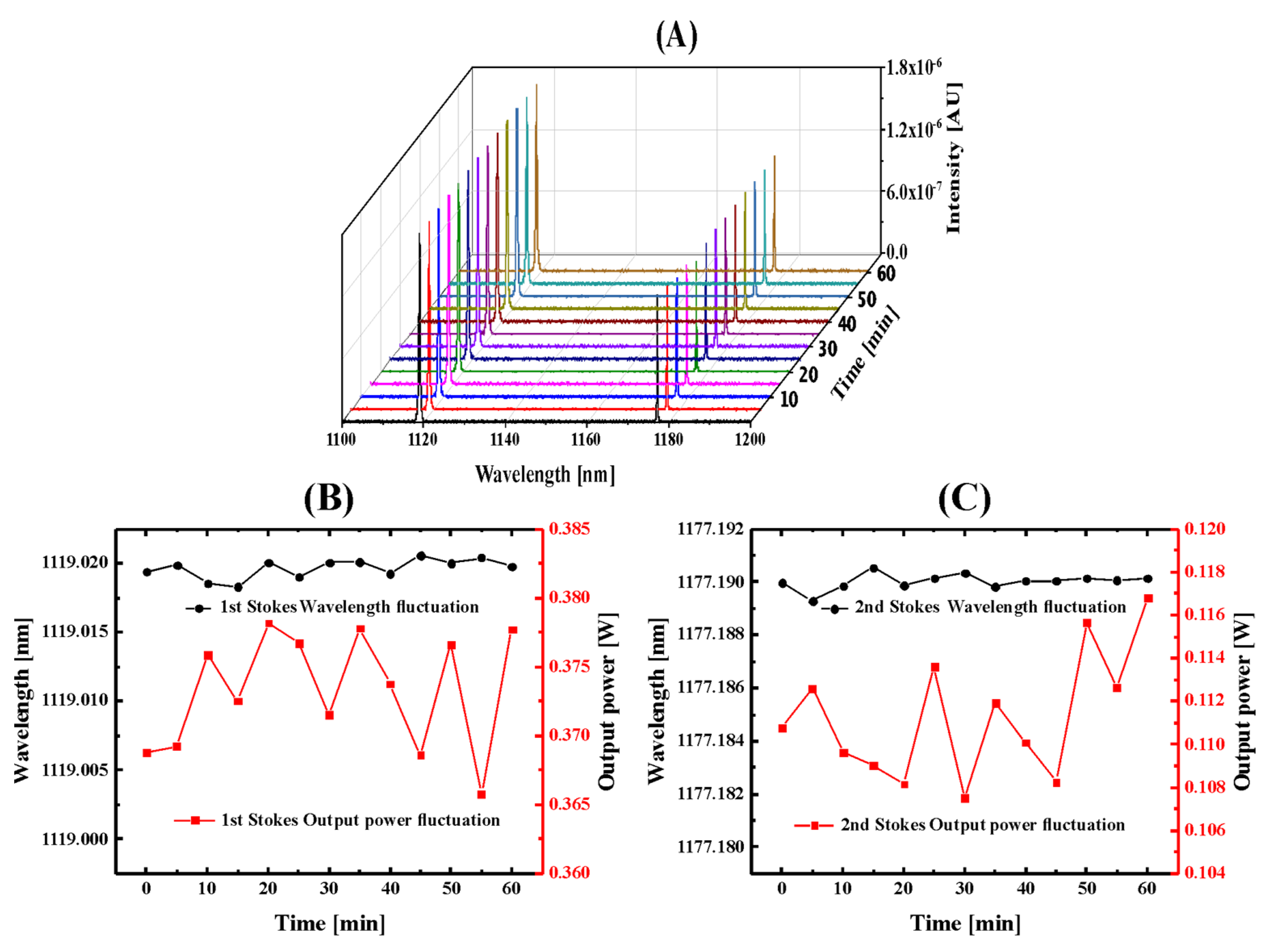
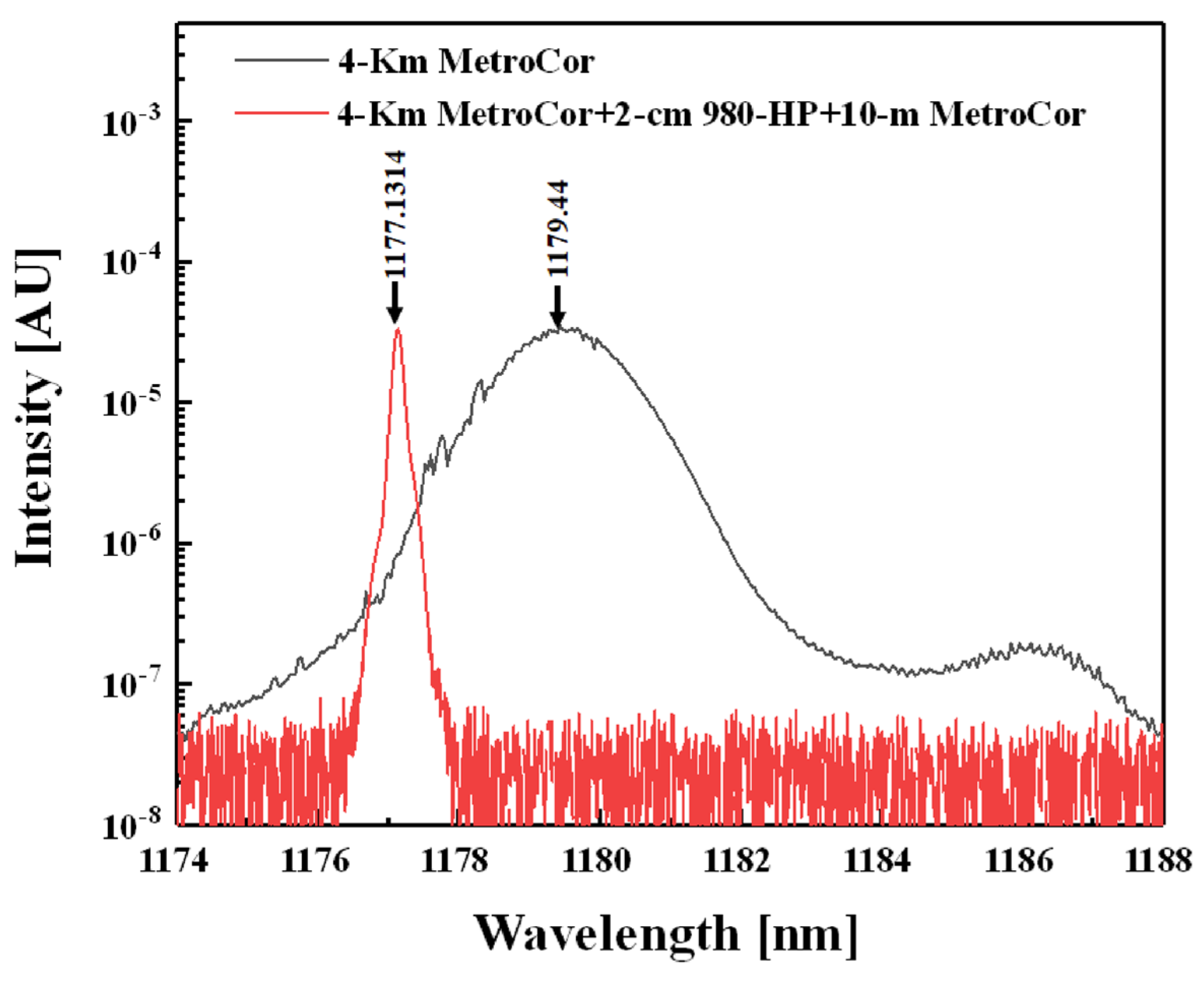
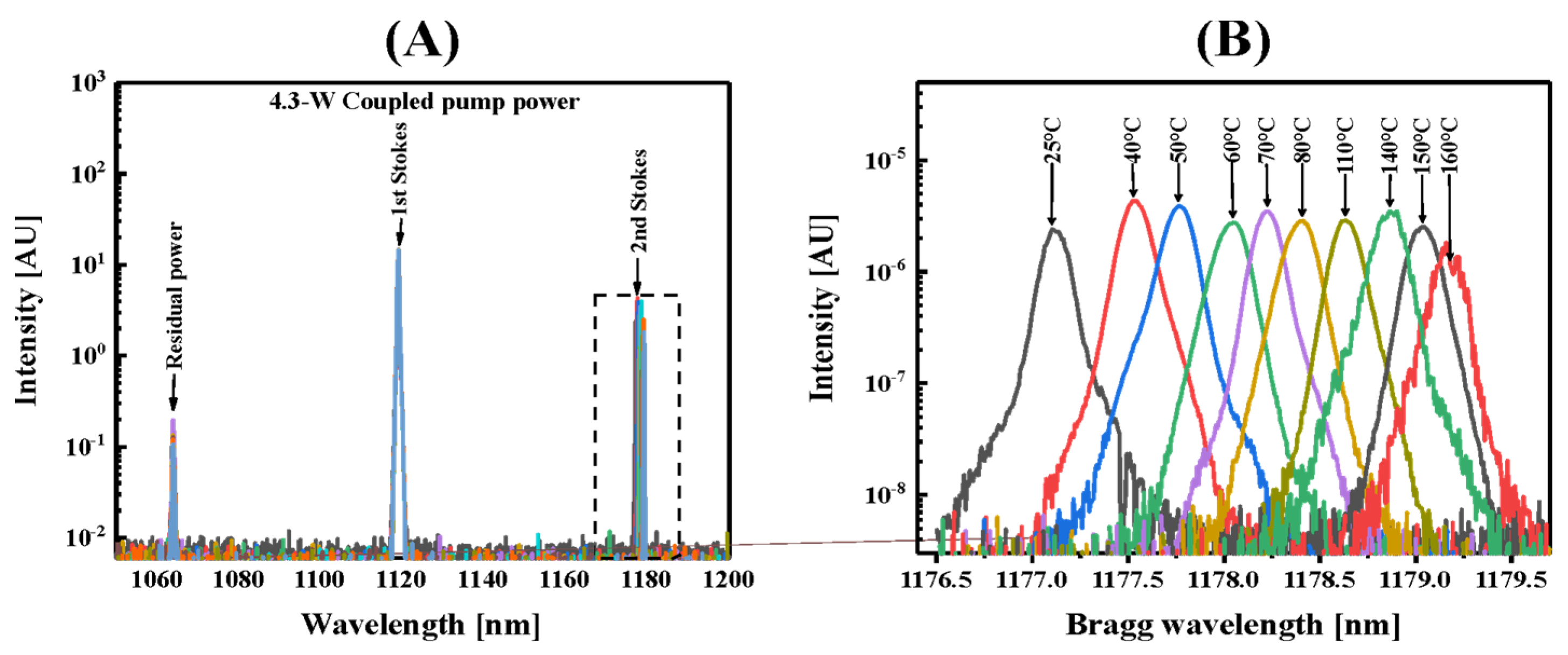
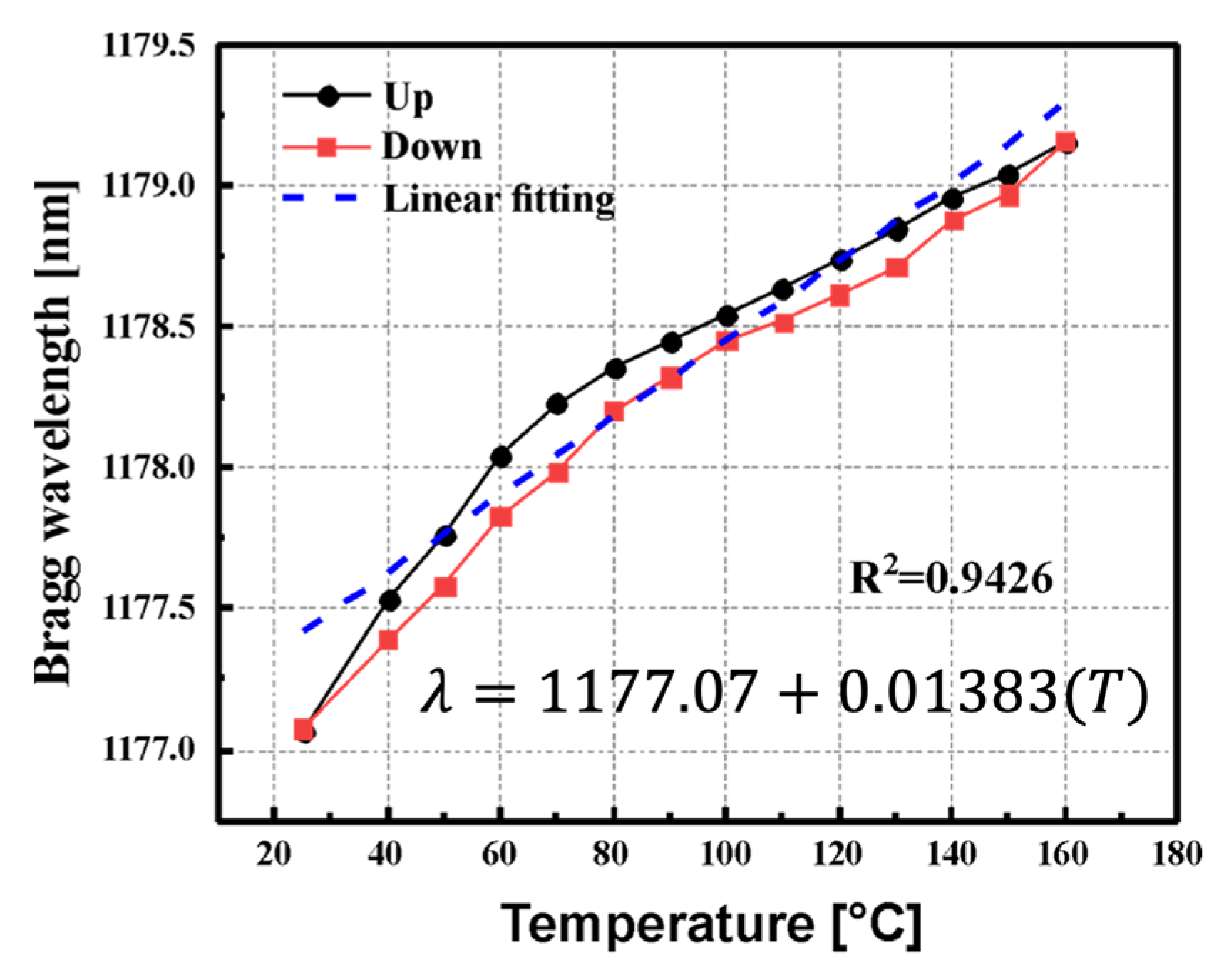
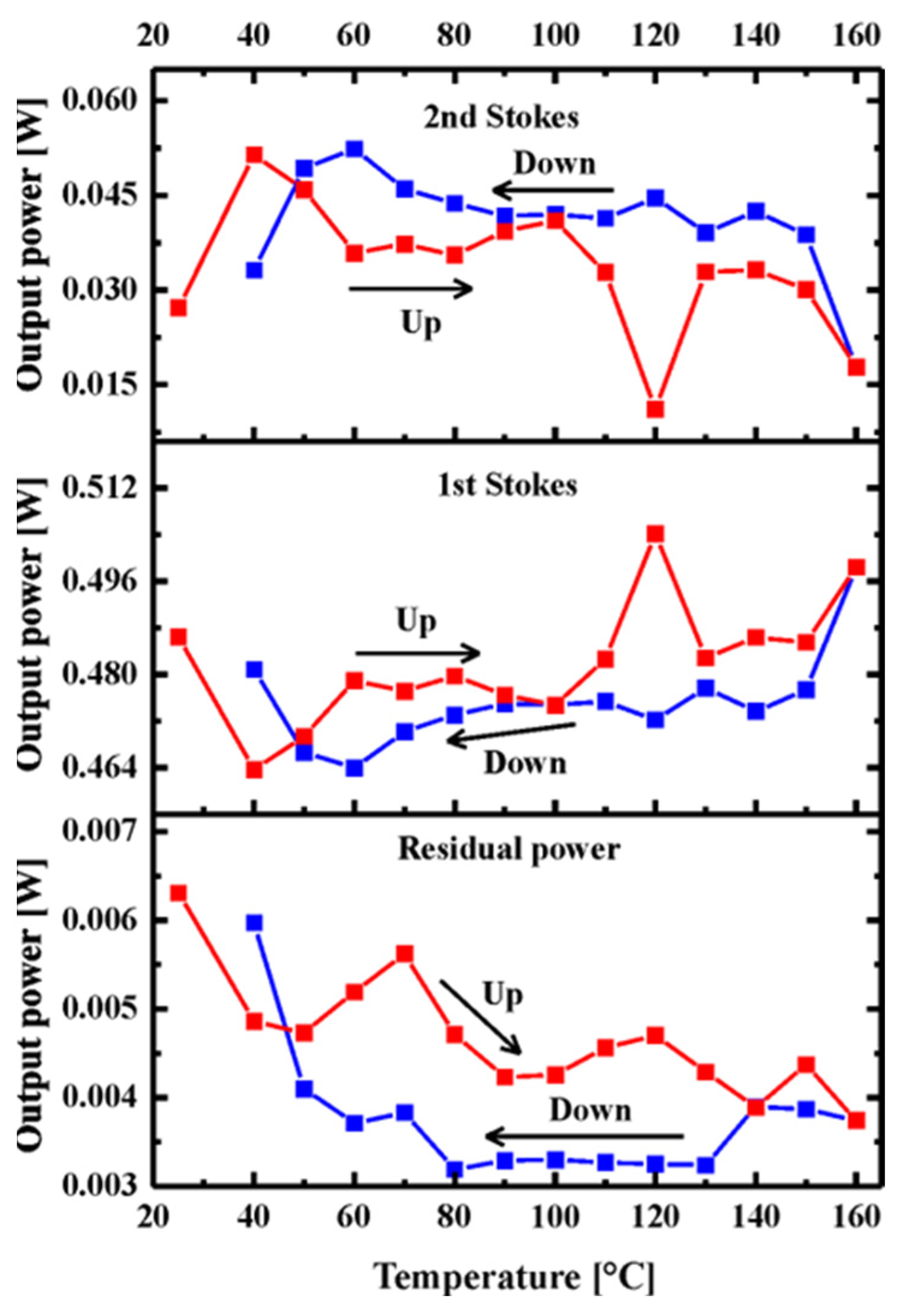

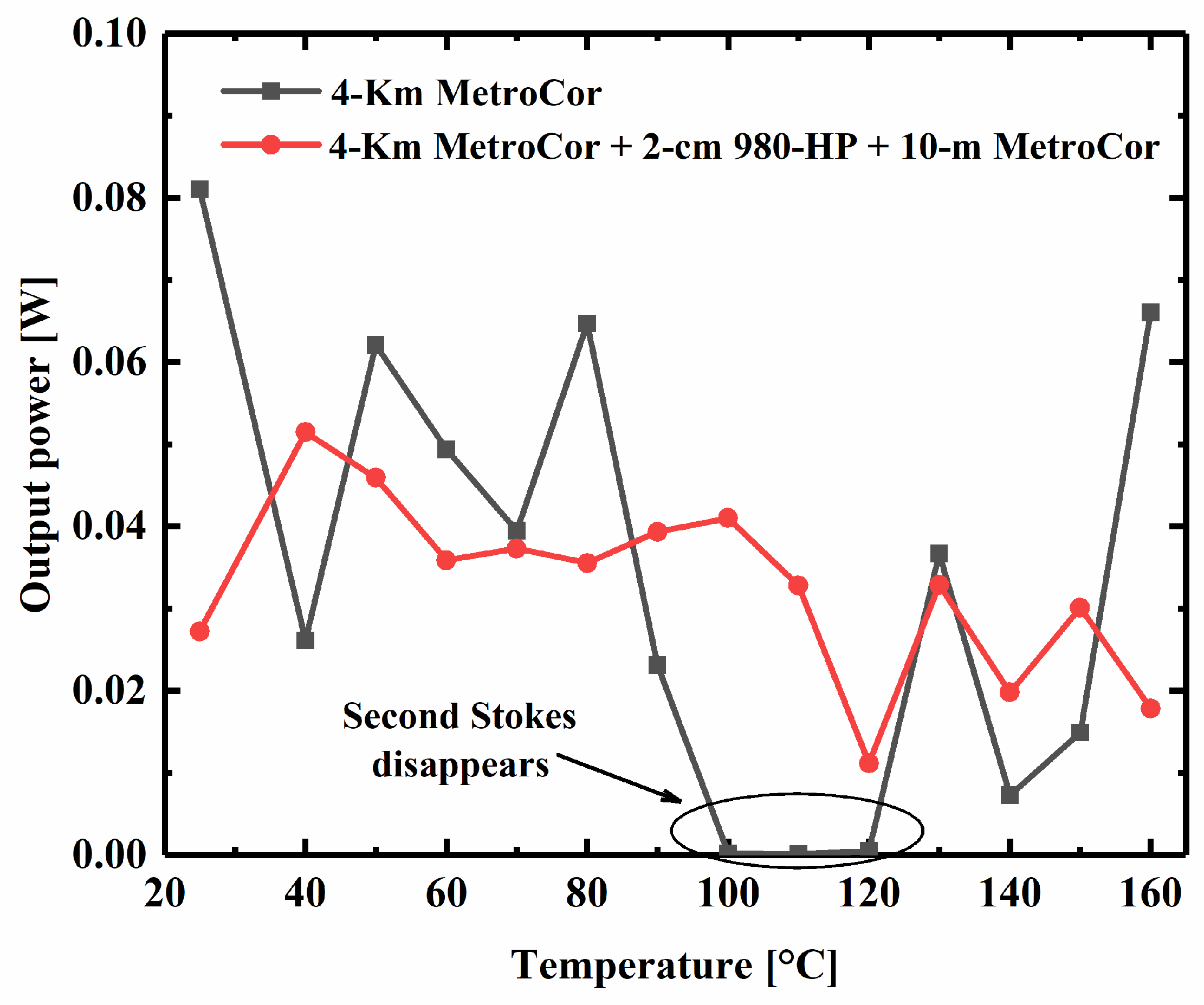
| Sensing Head | Sensitivity (pm/°C)/Temperature Range (°C) | Wavelength Operation (µm) | Ref/Year |
|---|---|---|---|
| FBG | 13.38/22–500 | 1.5 | [34]/2005 |
| FBG | 9.7/25–70 | 1.5 | [35]/2016 |
| All-Fiber Interferometer | 10/30–80 | 1.5 | [36]/2024 |
| LPFG | 8.61/35–60 | 1.5 | [37]/2024 |
| FBG | 11.9/20–150 | 1.5 | [38]/2024 |
| FBG | 15.07/35–160 | 1.1 | This Work |
Disclaimer/Publisher’s Note: The statements, opinions and data contained in all publications are solely those of the individual author(s) and contributor(s) and not of MDPI and/or the editor(s). MDPI and/or the editor(s) disclaim responsibility for any injury to people or property resulting from any ideas, methods, instructions or products referred to in the content. |
© 2025 by the authors. Licensee MDPI, Basel, Switzerland. This article is an open access article distributed under the terms and conditions of the Creative Commons Attribution (CC BY) license (https://creativecommons.org/licenses/by/4.0/).
Share and Cite
Coba-Ramos, J.A.; de la Cruz May, L.; Pages-Pacheco, A.Y.; Mejia-Beltran, E.; Jauregui-Vazquez, D.; May-Alarcon, M.; Sanchez-Lara, R.; Alvarez Chavez, J.A. Optimized Dual-Stokes Raman Laser for 1.1 µm Emission and Temperature Sensing. Photonics 2025, 12, 470. https://doi.org/10.3390/photonics12050470
Coba-Ramos JA, de la Cruz May L, Pages-Pacheco AY, Mejia-Beltran E, Jauregui-Vazquez D, May-Alarcon M, Sanchez-Lara R, Alvarez Chavez JA. Optimized Dual-Stokes Raman Laser for 1.1 µm Emission and Temperature Sensing. Photonics. 2025; 12(5):470. https://doi.org/10.3390/photonics12050470
Chicago/Turabian StyleCoba-Ramos, Jesus Alberto, Lelio de la Cruz May, Angeles Yolanda Pages-Pacheco, Efrain Mejia-Beltran, Daniel Jauregui-Vazquez, Manuel May-Alarcon, Rafael Sanchez-Lara, and Jose Alfredo Alvarez Chavez. 2025. "Optimized Dual-Stokes Raman Laser for 1.1 µm Emission and Temperature Sensing" Photonics 12, no. 5: 470. https://doi.org/10.3390/photonics12050470
APA StyleCoba-Ramos, J. A., de la Cruz May, L., Pages-Pacheco, A. Y., Mejia-Beltran, E., Jauregui-Vazquez, D., May-Alarcon, M., Sanchez-Lara, R., & Alvarez Chavez, J. A. (2025). Optimized Dual-Stokes Raman Laser for 1.1 µm Emission and Temperature Sensing. Photonics, 12(5), 470. https://doi.org/10.3390/photonics12050470





